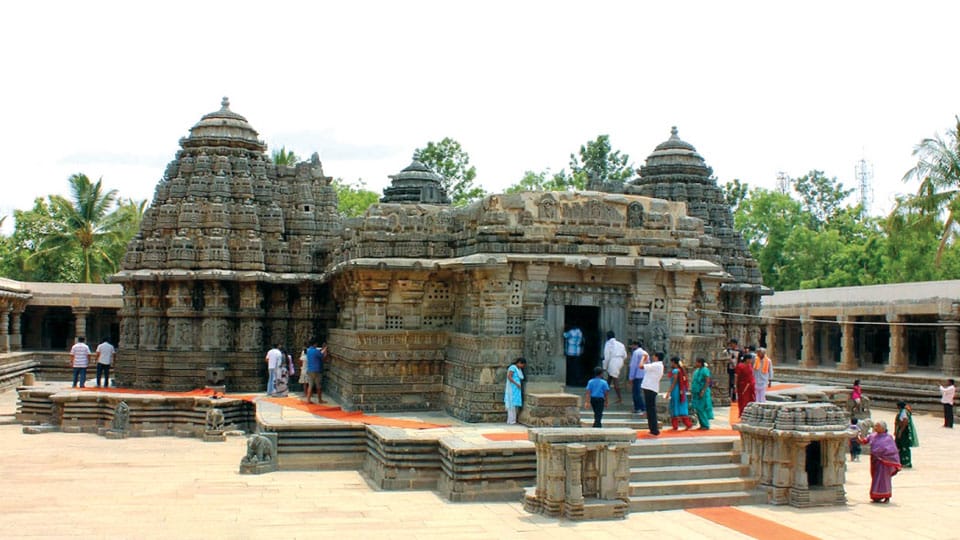Mysore/Mysuru: The Tourism Department and the Mysuru District Administration have drawn up plans to develop the Keshava Temple at Somnathpur in T. Narasipur Taluk at an estimated cost of Rs. 3.74 crore.
The Temple is located at a distance of 35 kilometres from Mysuru and the 13th-century structure is a paradise for art connoisseurs. At the tourism development meeting held at the Deputy Commissioner’s Office yesterday, officials also discussed the development of the Keshava Temple. The meeting, chaired by District Minister S.T. Somashekar, had taken a decision to scrap the controversial ropeway project atop Chamundi Hill.
Zilla Panchayat CEO B.R. Poornima, who holds the additional charge as Commissioner of the Department of Archaeology, Museums and Heritage, told the meeting that the historic temple was already in the UNESCO World Heritage Site status and any development should conform to the UNESCO guidelines.
According to the epigraphical records available with the Archaeological Survey of India (ASI), Soma, commander-in-chief of the Hoysala king Narasimha III (1254-1291 AD) built the shrine in 1268 AD. Built using a soft stone (greenish schist stone), every inch of the temple is adorned with various sculptures and the entire shrine is raised on a star-shaped moulded platform.
In their power-point presentation, the Tourism Department officials outlined the development proposal where two LED digital information boards will be set up at a cost of Rs. 25 lakh, a parking facility behind the temple at a cost of Rs. 50 lakh, service road (Rs. 15 lakh), a primary health centre (Rs. 50 lakh), renovation of the guest house (Rs. 88 lakh), food court (Rs. 70 lakh), solar lamps at parking place (Rs. 10 lakh), hi-tech toilets (Rs. 25 lakh) and electric sightseeing car (Rs. 15 lakh).
Reacting to the development works, T. Narasipur MLA Ashwin Kumar said that the ASI was not allowing any development within 200 metres of the temple. All the development works must start from the temple compound, he said.
Replying to the MLA, Deputy Commissioner Dr. Bagadi Gautham said, “We cannot change the UNESCO guidelines on heritage sites and temples. We have planned a comprehensive development without any harm to the temple structure and without violating the guidelines. Also, the plans will not trouble the residents.”








The last time I visited this temple premises in mid-1960s, when I was living in Mysore. This place was already in shambles, the temple architecture crumbling and important artefacts stolen and sold in the international black market for such historical artefacts, where rich private collectors buy them. These rich private collectors often use the archaeological and district authorities in the third world like India, to steal on demand artefacts of historical and archaeological vale. This was successfully achieved soon after Indian independence, when Indian politicians were haggling for power and positions and took their eyes of the country’s historical wealth. One could see this theft in Hampi, Belur and Halebid temples as well as in Somanathapura temple too, where if one carefully examines them see the absence of certain idols and related artefacts.
The successive DCs, ministers, archaeological officials and police officials for decades got their kickbacks by clandestinely working with the above rich private collectors living abroad. The customs officials too were involved to allow the export of these artefacts packaged in tea, fish and other Indian items in crates cleared for export.
What is standing there as the Chennakeshava Temple in Somanathapura now is just a skeletal temple with most smaller idols and other artefacts stolen and sold abroad. I also heard in 1950s that there were also attempts to dismantle parts of this temple, package them in large craters for export using the above channel of corrupt Indian official and political crowd involved, and reassemble them inside the private property of a rich private collector. Something went wrong as this plan was leaked out and abandoned.
In India, one has to keep watch of corrupt district , archaeological and customs officials as well their bosses the ministers. Most of them are corrupt and will do anything to get rich like cooperating with the criminal gangs who strip the country of precious archaeological artefacts and selling them.
The above poster is spot on.
Karnataka is particularly famous for exquisite ancient architecture. The Hoysala dynasty built temples with famed sculptors like Jakanachari and his son-their skills are seen in this Chennakeshava temple. Hence, any works of Jananachari is highly valued in the internal private collectors’ circuit mentioned above.
There has always been a collection of greedy , dishonest and corrupt priests, officials who are protected by politicians in power, and the illegal stealing and smuggling of historical artefacts related to Jakanachari and other items in Belur and Halebid took place decades ago.
The security is lax even today in the ancient temples of Karnataka in particular and in other states too. Rampant corruption involved with the collusion of priests and temple authorities as well as the police means idols and artefacts are being stripped out of these temples and sold to the international bidders for collectors.
The sad state of affairs in India has been that no one could be trusted then and more so now.
Smuggling thins in or out is a big enterprise in India. Gold ingots and high value USD currency buy the loyalty of ministers and officials including the CBI.
Devotees are the best people to watch out for corrupt priests and temple officials, as the idols which are placed around inside temples inside minor worship areas one could see in all ancient Karnataka temples are particularly vulnerable.